Designing Procedure Execution Tools with Emerging Technologies for Future Astronauts
Abstract
1. Introduction
1.1. Motivation
1.2. Training and Task Execution Research
- Fidelity: the graphics must have an acceptable level of resolution for the task
- Object properties: the objects in the scene must behave with sufficient reality
- Interactivity: the user must be able to interact with the virtual scene
- Sensory input: the user must receive appropriate sensory feedback
- Reactivity: the objects must behave appropriately when the user interacts with them
1.3. Usability of Emerging Technologies
2. Habitat Integration
2.1. Project Description
2.2. Research
2.3. Prototype
2.4. Conclusions
3. Ground Procedures
3.1. Project Description
3.2. Research
3.3. Prototype
3.4. Conclusions
4. Procedure Execution
4.1. Project Description
4.2. Research
4.3. Prototype
4.4. Conclusions
5. Just-in-Time Training
5.1. Project Description
5.2. Research
5.3. Prototype
5.4. Conclusions
6. Discussion and Concluding Remarks
Author Contributions
Funding
Institutional Review Board Statement
Informed Consent Statement
Data Availability Statement
Acknowledgments
Conflicts of Interest
Abbreviations
| AR | Augmented Reality |
| ARC | Ames Research Center |
| BLE | Bluetooth Low Energy |
| HCI | Human-Computer Interaction |
| HMD | Head Mounted Display |
| IoT | Internet of Things |
| ISS | International Space Station |
| IV | Intra-Vehicular |
| KSC | Kennedy Space Center |
| LDEMs | Long-Duration Exploration Missions |
| LED | Light-Emitting Diode |
| MCC | Mission Control Center |
| NASA | National Aeronautics and Space Administration |
| OR | Operating Room |
| Portable Document Format | |
| SHARP | Smart Habitat Augmented Reality Procedure |
| TOSC | Test and Operations Support Contract |
| UI | User Interface |
| VR | Virtual Reality |
| WAD | Work Authorization Document |
References
- Sonett, C. Report of the Ad Hoc Working Group on Apollo Experiments and Training on the Scientific Aspects of the Apollo Program; Technical Report; NASA: Washington, DC, USA, 1963. [Google Scholar]
- Drake, B.G. Human Exploration of Mars Design Reference Architecture 5.0; Technical Report NASA-SP-2009-566; NASA: Washington, DC, USA, 2009. [Google Scholar]
- Smith, M.; Craig, D.; Herrmann, N.; Mahoney, E.; Krezel, J.; McIntyre, N.; Goodliff, K. The Artemis Program: An Overview of NASA’s Activities to Return Humans to the Moon. In Proceedings of the 2020 IEEE Aerospace Conference, Big Sky, MT, USA, 7–14 March 2020; pp. 1–10. [Google Scholar] [CrossRef]
- Drake, B.G.; Hoffman, S.J.; Beaty, D.W. Human exploration of Mars, Design Reference Architecture 5.0. In Proceedings of the 2010 IEEE Aerospace Conference, Big Sky, MT, USA, 6–13 March 2010; pp. 1–24. [Google Scholar] [CrossRef]
- Satava, R.M. Virtual reality surgical simulator: The first steps. Surg. Endosc. 1993, 7, 203–205. [Google Scholar] [CrossRef] [PubMed]
- Kühnapfel, U.; Çakmak, H.; Maaß, H. Endoscopic surgery training using virtual reality and deformable tissue simulation. Comput. Graph. 2000, 24, 671–682. [Google Scholar] [CrossRef]
- Seymour, N.E.; Gallagher, A.G.; Roman, S.A.; O’Brien, M.K.; Bansal, V.K.; Andersen, D.K.; Satava, R.M. Virtual Reality Training Improves Operating Room Performance: Results of a Randomized, Double-Blinded Study. Ann. Surg. 2002, 236, 458–464. [Google Scholar] [CrossRef] [PubMed]
- Grantcharov, T.P.; Kristiansen, V.B.; Bendix, J.; Bardram, L.; Rosenberg, J.; Funch-Jensen, P. Randomized clinical trial of virtual reality simulation for laparoscopic skills training. Br. J. Surg. 2004, 91, 146–150. [Google Scholar] [CrossRef] [PubMed]
- Boud, A.; Haniff, D.; Baber, C.; Steiner, S. Virtual reality and augmented reality as a training tool for assembly tasks. In Proceedings of the 1999 IEEE International Conference on Information Visualization (Cat. No. PR00210), London, UK, 16–18 July 1999; pp. 32–36. [Google Scholar] [CrossRef]
- Webel, S.; Bockholt, U.; Engelke, T.; Gavish, N.; Olbrich, M.; Preusche, C. An augmented reality training platform for assembly and maintenance skills. Robot. Auton. Syst. 2013, 61, 398–403. [Google Scholar] [CrossRef]
- Norouzi, N.; Bruder, G.; Belna, B.; Mutter, S.; Turgut, D.; Welch, G. A Systematic Review of the Convergence of Augmented Reality, Intelligent Virtual Agents, and the Internet of Things. In Artificial Intelligence in IoT; Al-Turjman, F., Ed.; Springer International Publishing: Cham, Switzerland, 2019; pp. 1–24. [Google Scholar] [CrossRef]
- Kim, J.C. Multimodal Interaction with Internet of Things and Augmented Reality: Foundations, Systems and Challenges; Luleå University of Technology: Luleå, Sweden, 2020. [Google Scholar]
- Al-Fuqaha, A.; Guizani, M.; Mohammadi, M.; Aledhari, M.; Ayyash, M. Internet of Things: A Survey on Enabling Technologies, Protocols, and Applications. IEEE Commun. Surv. Tutor. 2015, 17, 2347–2376. [Google Scholar] [CrossRef]
- Giménez, R.; Pous, M.; Tecnològic, B.C. Augmented reality as an enabling factor for the Internet of Things. In Proceedings of the W3C Workshop: Augmented Reality on the Web, Barcelona, Spain, 15–16 June 2010. [Google Scholar]
- Zhang, L.; Chen, S.; Dong, H.; El Saddik, A. Visualizing Toronto City Data with HoloLens: Using Augmented Reality for a City Model. IEEE Consum. Electron. Mag. 2018, 7, 73–80. [Google Scholar] [CrossRef]
- Phupattanasilp, P.; Tong, S.R. Augmented Reality in the Integrative Internet of Things (AR-IoT): Application for Precision Farming. Sustainability 2019, 11, 2658. [Google Scholar] [CrossRef]
- Cao, Y.; Xu, Z.; Li, F.; Zhong, W.; Huo, K.; Ramani, K.V. Ra: An In-Situ Visual Authoring System for Robot-IoT Task Planning with Augmented Reality. In Proceedings of the 2019 on Designing Interactive Systems Conference; ACM: San Diego, CA, USA, 2019; pp. 1059–1070. [Google Scholar] [CrossRef]
- Alam, M.F.; Katsikas, S.; Beltramello, O.; Hadjiefthymiades, S. Augmented and virtual reality based monitoring and safety system: A prototype IoT platform. J. Netw. Comput. Appl. 2017, 89, 109–119. [Google Scholar] [CrossRef]
- Sauer, J.; Sonderegger, A. The influence of prototype fidelity and aesthetics of design in usability tests: Effects on user behaviour, subjective evaluation and emotion. Appl. Ergon. 2009, 40, 670–677. [Google Scholar] [CrossRef] [PubMed]
- Lim, Y.K.; Stolterman, E.; Tenenberg, J. The anatomy of prototypes: Prototypes as filters, prototypes as manifestations of design ideas. Acm Trans. Comput. Hum. Interact. 2008, 15, 1–27. [Google Scholar] [CrossRef]
- McCurdy, M.; Connors, C.; Pyrzak, G.; Kanefsky, B.; Vera, A. Breaking the fidelity barrier: An examination of our current characterization of prototypes and an example of a mixed-fidelity success. In Proceedings of the SIGCHI Conference on Human Factors in Computing Systems—CHI, Montréal, QC, Canada, 23–28 June 2006; ACM Press: Montréal, QC, Canada, 2006; p. 1233. [Google Scholar] [CrossRef]
- McCurdy, M. Planning tools for Mars surface operations: Human-Computer Interaction lessons learned. In Proceedings of the 2009 IEEE Aerospace Conference, Big Sky, MT, USA, 7–14 March 2009; pp. 1–12. [Google Scholar] [CrossRef]
- Marquez, J.J.; Pyrzak, G.; Hashemi, S.; McMillin, K.; Medwid, J. Supporting Real-Time Operations and Execution through Timeline and Scheduling Aids. In Proceedings of the 43rd International Conference on Environmental Systems; American Institute of Aeronautics and Astronautics: Vail, CO, USA, 2013. [Google Scholar] [CrossRef]
- Nielsen, J.; Phillips, V.L. Estimating the relative usability of two interfaces: Heuristic, formal, and empirical methods compared. In Proceedings of the INTERACT ’93 and CHI ’93 Conference on Human Factors in Computing Systems; Association for Computing Machinery: Amsterdam, The Netherlands, 1993; pp. 214–221. [Google Scholar] [CrossRef]
- Nielsen, J. Designing Web Usability; New Riders: Indianapolis, IN, USA, 2000. [Google Scholar]
- Clark, R.C.; Mayer, R.E. E-Learning and the Science of Instruction: Proven Guidelines for Consumers and Designers of Multimedia Learning; Pfeiffer: San Francisco, CA, USA, 2003. [Google Scholar]
- Chandler, P.; Sweller, J. Cognitive Load While Learning to Use a Computer Program. Appl. Cogn. Psychol. 1996, 10, 151–170. [Google Scholar] [CrossRef]
- Koedinger, K.R.; Booth, J.L.; Klahr, D. Instructional Complexity and the Science to Constrain It. Science 2013, 342, 935–937. [Google Scholar] [CrossRef] [PubMed]
- Margulieux, L.E.; Guzdial, M.; Catrambone, R. Subgoal-labeled instructional material improves performance and transfer in learning to develop mobile applications. In Proceedings of the Ninth Annual International Conference on International Computing Education Research—ICER ’12; ACM Press: Auckland, New Zealand, 2012; p. 71. [Google Scholar] [CrossRef]
- Fogarty, J.; Hudson, S.E.; Atkeson, C.G.; Avrahami, D.; Forlizzi, J.; Kiesler, S.; Lee, J.C.; Yang, J. Predicting human interruptibility with sensors. Acm Trans. Comput. Hum. Interact. 2005, 12, 119–146. [Google Scholar] [CrossRef]
- Hooper, C.J.; Olivier, P.; Preston, A.; Balaam, M.; Seedhouse, P.; Jackson, D.; Pham, C.; Ladha, C.; Ladha, K.; Plötz, T. The french kitchen: Task-based learning in an instrumented kitchen. In Proceedings of the 2012 ACM Conference on Ubiquitous Computing—UbiComp ’12; ACM Press: Pittsburgh, PA, USA, 2012; p. 193. [Google Scholar] [CrossRef]
- Haniff, D.; Baber, C. User evaluation of augmented reality systems. In Proceedings of the Seventh International Conference on Information Visualization (IV 2003), London, UK, 18 July 2003; pp. 505–511. [Google Scholar] [CrossRef]
- Henderson, S.J.; Feiner, S. Evaluating the benefits of augmented reality for task localization in maintenance of an armored personnel carrier turret. In Proceedings of the 2009 8th IEEE International Symposium on Mixed and Augmented Reality, Orlando, FL, USA, 19–22 October 2009; pp. 135–144. [Google Scholar] [CrossRef]
- Marner, M.R.; Irlitti, A.; Thomas, B.H. Improving procedural task performance with Augmented Reality annotations. In Proceedings of the 2013 IEEE International Symposium on Mixed and Augmented Reality (ISMAR), Adelaide, SA, Australia, 1–4 October 2013; pp. 39–48. [Google Scholar] [CrossRef]
- Fink, P.W.; Kennedy, T.F.; Rodriguez, L.; Broyan, J.L.; Ngo, P.H.; Chu, A.; Yang, A.; Schmalholz, D.M.; Stonestreet, R.W.; Adams, R.C.; et al. Autonomous Logistics Management Systems for Exploration Missions. In AIAA SPACE and Astronautics Forum and Exposition; American Institute of Aeronautics and Astronautics: Orlando, FL, USA, 2017. [Google Scholar] [CrossRef]
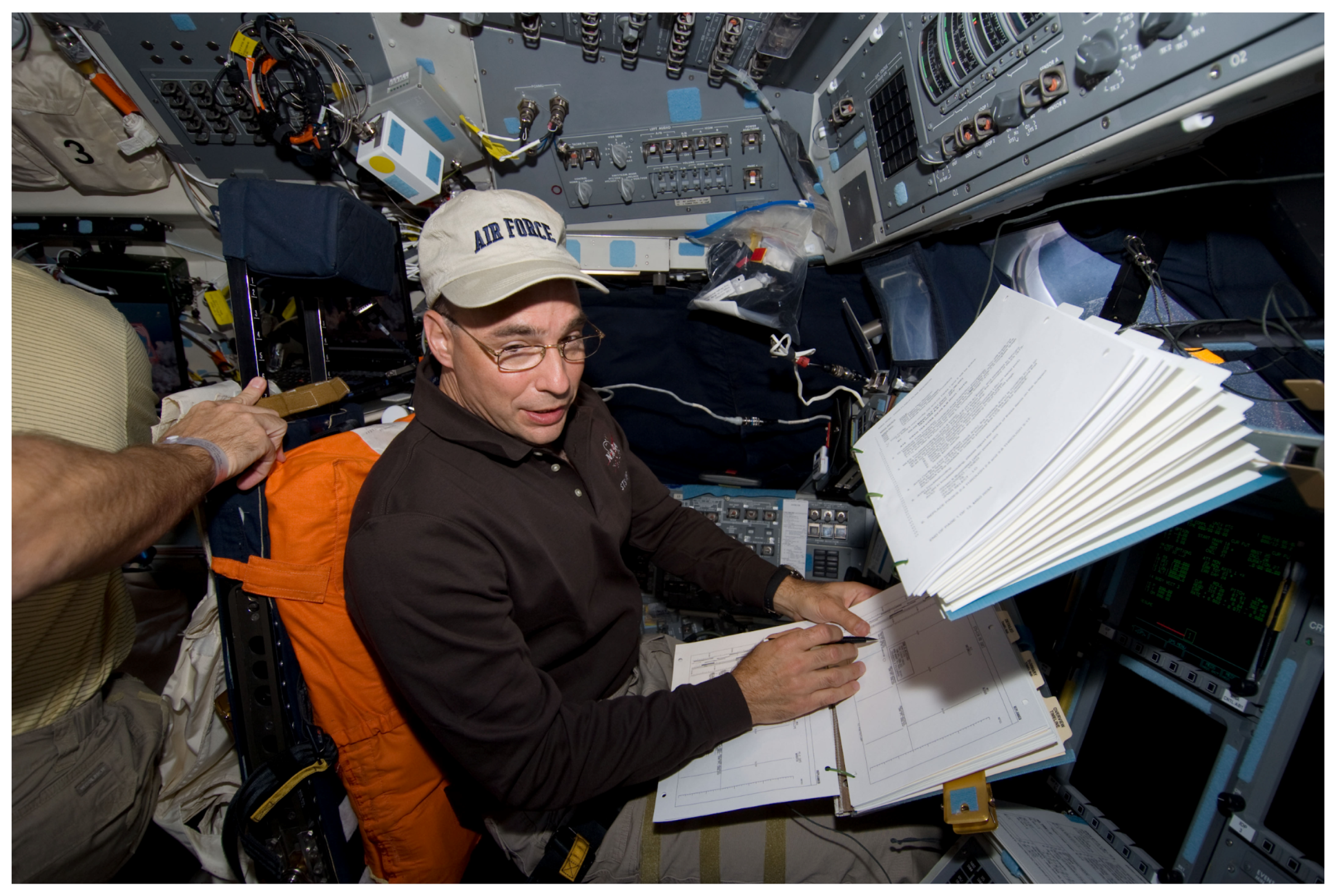
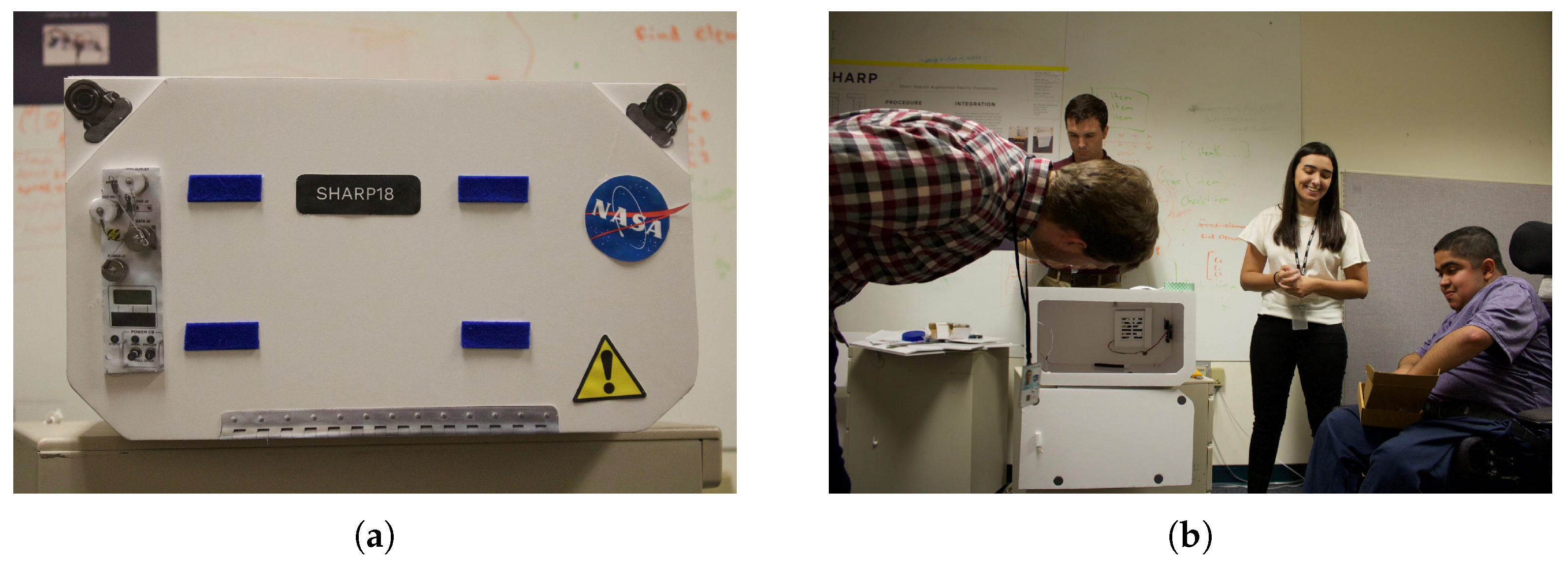


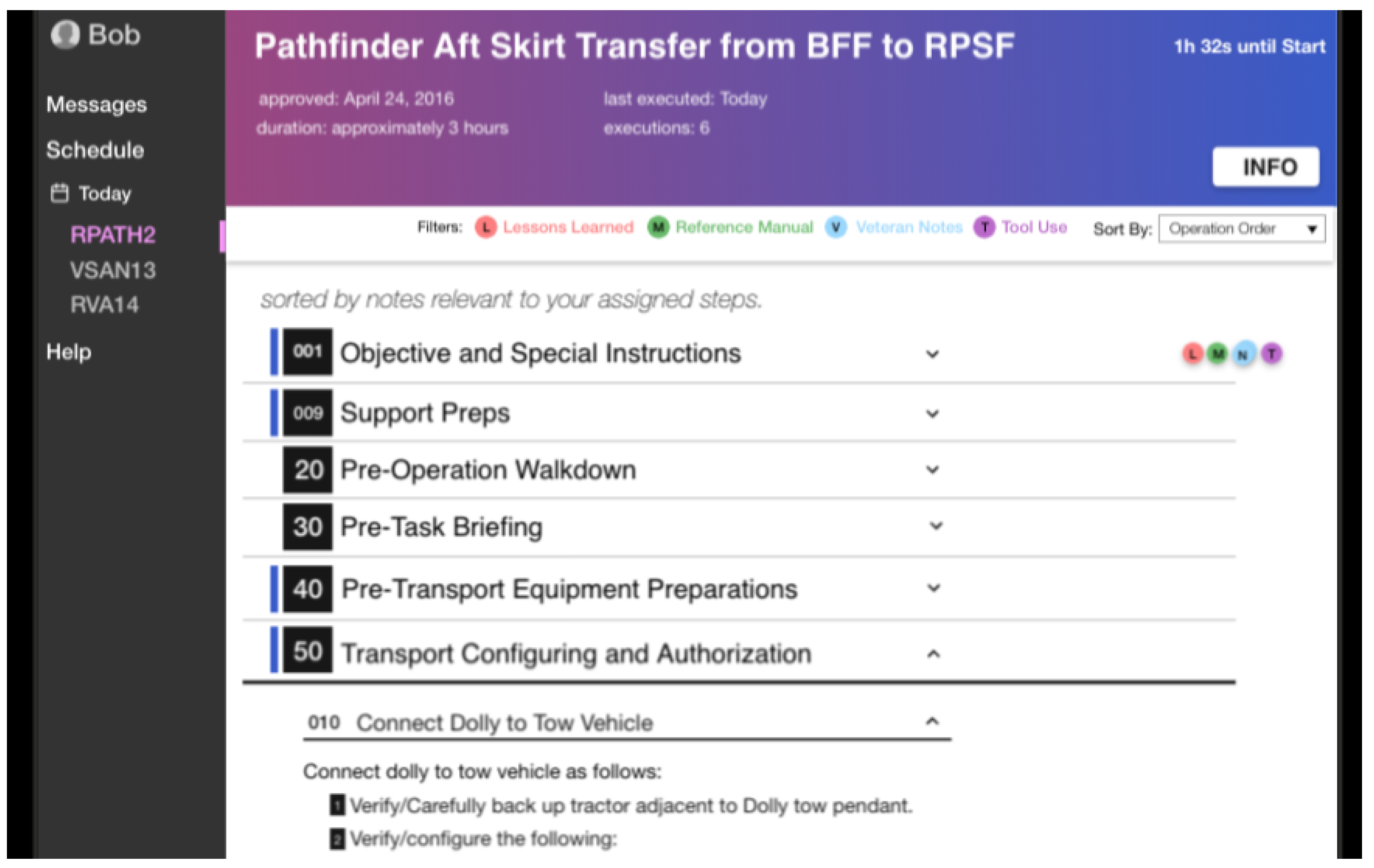


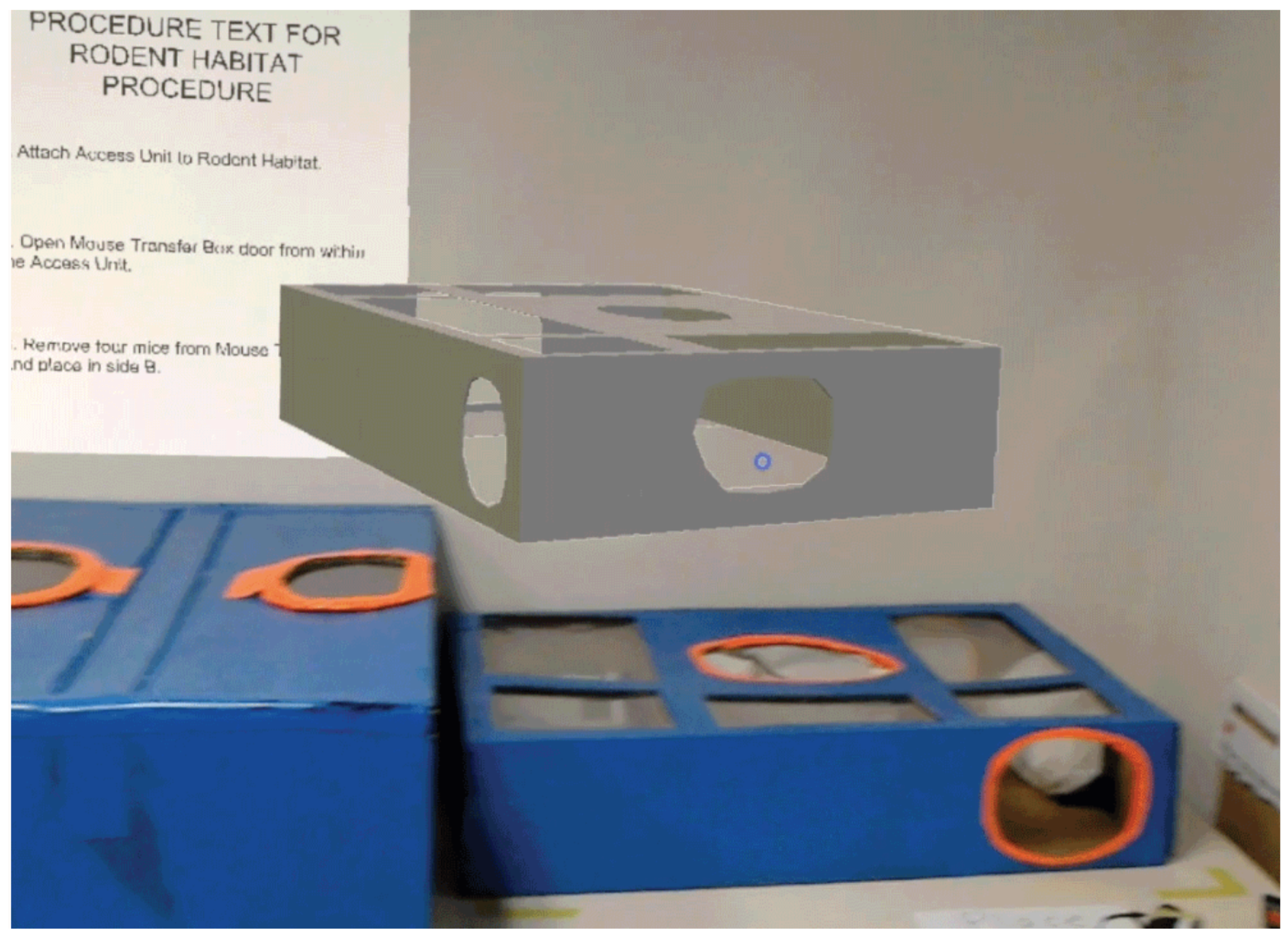
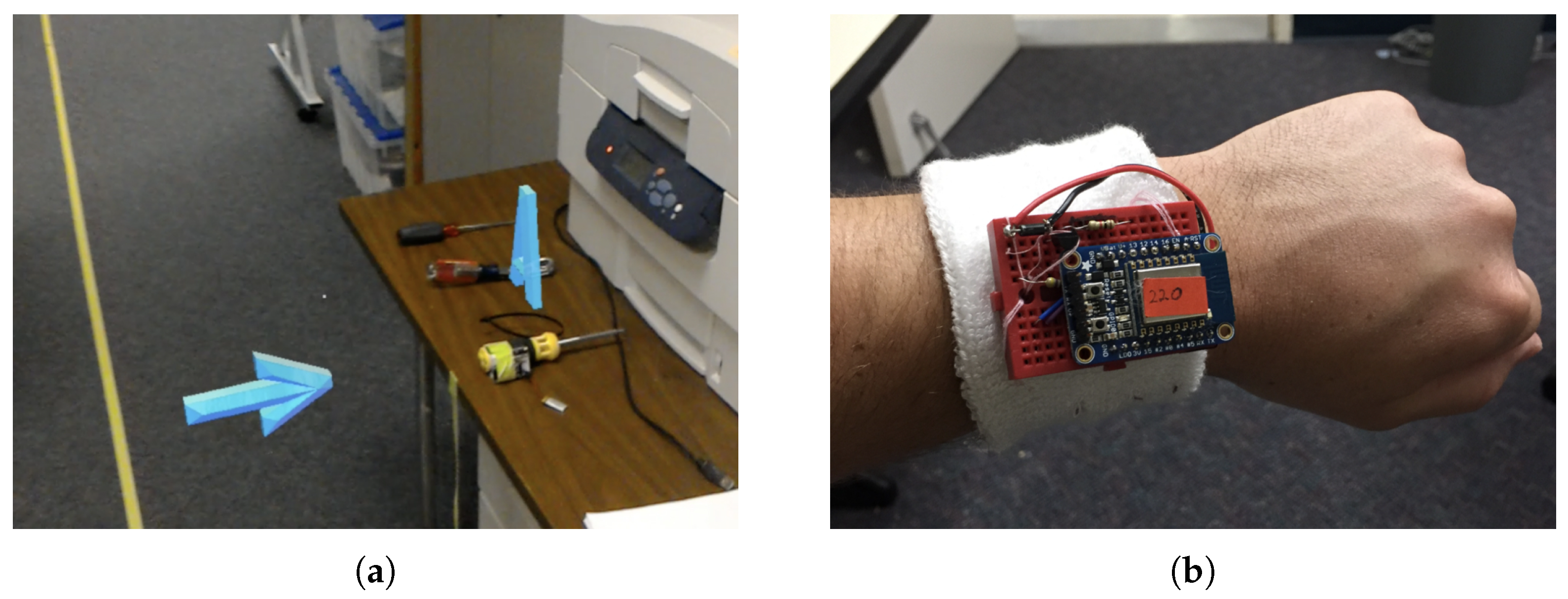
Publisher’s Note: MDPI stays neutral with regard to jurisdictional claims in published maps and institutional affiliations. |
© 2021 by the authors. Licensee MDPI, Basel, Switzerland. This article is an open access article distributed under the terms and conditions of the Creative Commons Attribution (CC BY) license (http://creativecommons.org/licenses/by/4.0/).
Share and Cite
Karasinski, J.A.; Torron Valverde, I.C.; Brosnahan, H.L.; Gale, J.W.; Kim, R.; Yashar, M.; Marquez, J.J. Designing Procedure Execution Tools with Emerging Technologies for Future Astronauts. Appl. Sci. 2021, 11, 1607. https://doi.org/10.3390/app11041607
Karasinski JA, Torron Valverde IC, Brosnahan HL, Gale JW, Kim R, Yashar M, Marquez JJ. Designing Procedure Execution Tools with Emerging Technologies for Future Astronauts. Applied Sciences. 2021; 11(4):1607. https://doi.org/10.3390/app11041607
Chicago/Turabian StyleKarasinski, John A., Isabel C. Torron Valverde, Holly L. Brosnahan, Jack W. Gale, Ron Kim, Melodie Yashar, and Jessica J. Marquez. 2021. "Designing Procedure Execution Tools with Emerging Technologies for Future Astronauts" Applied Sciences 11, no. 4: 1607. https://doi.org/10.3390/app11041607
APA StyleKarasinski, J. A., Torron Valverde, I. C., Brosnahan, H. L., Gale, J. W., Kim, R., Yashar, M., & Marquez, J. J. (2021). Designing Procedure Execution Tools with Emerging Technologies for Future Astronauts. Applied Sciences, 11(4), 1607. https://doi.org/10.3390/app11041607






